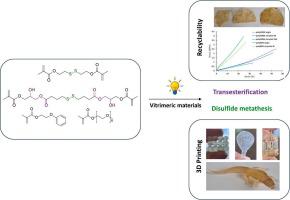Reactive & Functional Polymers ( IF 5.1 ) Pub Date : 2024-01-04 , DOI: 10.1016/j.reactfunctpolym.2023.105825 Anna Vilanova-Pérez , Sasan Moradi , Osman Konuray , Xavier Ramis , Adrià Roig , Xavier Fernández-Francos

|
Two new vitrimeric materials have been studied for potential additive manufacturing applications such as 3D-printing. A monomer containing disulfide bonds and β-hydroxyesters was easily synthesized from two low-cost and commercially available reagents. Another disulfide-containing monomer was synthesized for comparison purposes. Materials were prepared through a UV-light radical polymerization of methacrylates. The addition of two reactive diluents such as poly(ethylene glycol) methyl ether methacrylate (PEGMA) and ethylene glycol phenyl ether methacrylate (EGPMA) was necessary to achieve a suitable viscosity for the curing as well as for their printability. The curing process was controlled by FTIR. Thermomechanical properties were investigated by means of DMTA analysis revealing near-ambient Tg values. Stress relaxation tests revealed that both materials were capable to relax the 63% of the initial stress in less than 10 min at 110 °C. The recyclability of the materials was achieved, and the mechanical and thermomechanical properties of the recycled samples were compared to the virgin ones revealing a great recovery of the initial properties. Finally, Digital Light Processing (DLP) technique was used to print complex structures with high resolution highlighting the great potential of these vitrimeric materials in 3D printing.
中文翻译:

利用二硫键和酯交换键交换反应生产可回收和可再加工的 3D 打印 vitrimer
两种新型玻璃材料已被研究用于潜在的增材制造应用,例如 3D 打印。含有二硫键和β-羟基酯的单体很容易由两种低成本且市售的试剂合成。为了比较目的,合成了另一种含二硫化物的单体。材料是通过甲基丙烯酸酯的紫外光自由基聚合制备的。需要添加两种反应性稀释剂,例如聚乙二醇甲醚甲基丙烯酸酯 (PEGMA) 和乙二醇苯基醚甲基丙烯酸酯 (EGPMA),以达到适合固化的粘度以及印刷适性。固化过程由 FTIR 控制。通过 DMTA 分析研究热机械性能,揭示接近环境的Tg值。应力松弛测试表明,两种材料在 110 °C 下都能在 10 分钟内松弛 63% 的初始应力。实现了材料的可回收性,并将回收样品的机械和热机械性能与原始样品进行了比较,表明初始性能得到了很大的恢复。最后,数字光处理 (DLP) 技术用于以高分辨率打印复杂结构,凸显了这些玻璃体材料在 3D 打印中的巨大潜力。



























 京公网安备 11010802027423号
京公网安备 11010802027423号